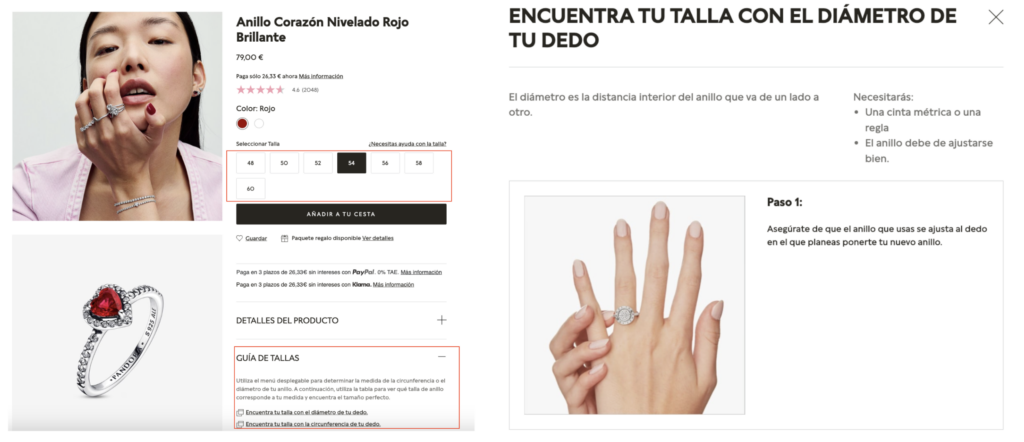Guide to product sheets in 2024 for ecommerce
The product sheets of any e-commerce are the last link that exists before a user ends up purchasing our product.
That is why we must have our product pages focused both on obtaining visibility in search engines and designing them to obtain the highest possible conversion rates.
Below I tell you different important aspects to take into account. Let’s go for it!
First thing: research those products that have the greatest search demand
Lo primero que debemos preguntarnos es ¿Se demandan de forma directa en Google los productos y referencias que tengo en mi catálogo? ¿Existe una demanda suficiente que vaya a generar un impacto en mi negocio?
Si poseemos una tienda multimarca es más probable que tengamos productos que se demanden, pero si disponemos de nuestros propios productos deberemos hacer un análisis del interés que generan cada uno de ellos en los buscadores.
Para ello, podemos servirnos de herramientas como Google Search Console y en el informe de rendimiento podemos filtrar por todas aquellas URLs de producto y ver para que consultas están recibiendo más impresiones.
En el momento que veamos suficiente demanda de búsqueda podemos determinar la necesidad de implementar diferentes mejoras en nuestras fichas de producto. También podemos ver aquellos productos más populares o cuya posición media esté cercana a los primeros resultados, ya que de esta forma las acciones que podamos realizar nos ayuden a escalar hacia las primeras posiciones.
Take into account the basic SEO aspects
Lo primero y más sencillo que podemos hacer es mejorar el título y encabezados que presenten nuestras ficha de producto. Asegurarnos que estas etiquetas contienen la palabra clave por la que pretendemos posicionar en Google (tanto en la etiqueta <title> como en el <h1>).
Por otro lado, debemos asegurarnos que estas páginas están enlazadas tanto desde dentro del sitio web así como desde nuestro archivo sitemap.
Adapt the content to the pains of your potential client
It is very common to see text sections in different ecommerce that complement the product information. Even so, not in all cases this information is relevant to the user and facilitates the conversion.
To do this, we must know our own product and determine what questions or solutions we can provide to our potential customers about it.
For example, if we want to buy a ring, it may be the case that we are not sure what size we need. It may seem obvious, but not all e-commerce stores visibly include a size guide that provides us with this information within the product sheet. Below we see an example from pandora.net.

For those who are more fans of the world of watches, we can find different attributes that can lead us to choose one or the other. Therefore, we see how Reloj.es includes both within its product listing pages and in its files the possibility of comparing the watches we want.
In this way we see at a first glance a comparison of all those attributes that interest us. Along with this, we can see the green add to cart buttons that accompany us throughout the analysis of the information for when we are clear about which watch best meets our needs.
At the same time, we find a series of common aspects to highlight, such as shipping time, financing (alternatives in terms, installments and times) or shipping cost.
Usability and design
Our product sheets must be intuitive. Showing the information appropriately and with a design that is easy on the eyes will also make it easier for users to feel comfortable on the page.
There are products such as computers that have numerous specifications that we must take into account. Showing all this information in plain text can be tedious to read. However, displaying all the information in formats such as a table makes all the information more digestible.
Below we see an example from bechtle.com where we see how the information is displayed in a clean way and also, no matter how much we scroll to read the information, the add to cart button accompanies us at all times.
On the other hand, if we see the pccomponentes.com files we see how with a simple glance we can select the different attributes that mark the computer we want and where everything works in a really agile way.
These are just some of the examples that we can find. The idea is to show useful information to users based on the type of product and do it in a suggestive way that is intuitive and usable.
Images
The images on the product sheets are of great importance. Having them well optimized in terms of weight and dimensions is essential. Including sliders with different types of images as well as the possibility of zooming to view product details are very good practices.
Due to the numerous changes that Google presents in its results sheets, as well as the importance that product sheets can have within the SGE, it seems that having optimized product sheets with a good image format can be a differentiating fact.
For example, about two months ago, Google included the elements “products” and “product sites” for certain transactional searches.
If we take a look at the results shown by the “products” sheet we can see how the vast majority shows URLs of product sheets and when selecting one of them it shows us a small SERP where we can see different purchase alternatives.
That is why having optimized images can make it easier for us to appear in these results and try to increase our CTR.
Structured data
It is absolutely necessary to implement structured data in our product sheets. This provides Google bots with information on aspects such as price, ratings, reviews, stock, etc.
Including this series of information can make it easier for Google to include it as a featured element within our snippet in the results sheet and thereby increase our CTR.
In this link I leave you the official Google documentation in this regard.
The role of product sheets with SGE
The ever-closer arrival of generative SERPs in Europe will cause changes in the way Google presents information in its results sheets. In fact, we can already see its first formats in the United States.
Although it remains to be seen how this will affect the capture of traffic from the search engine, we can see how, in the face of different searches, Google provides the result generated by AI and subsequently different reference sources.
It is possible that in this aspect, the product sheets are even more relevant and that, in the face of transactional searches, Google will include new snippets in which the product sheets that resolve the search intention of the queries predominate.
At SEOCOM we can ensure that your ecommerce does not stop growing.
